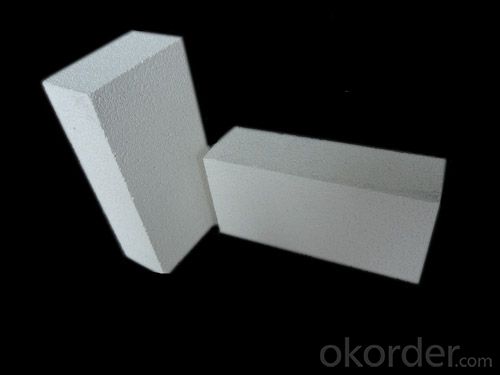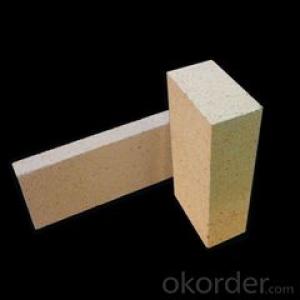Insulating Fire Brick - Refractory JM Mullite Insulation Brick at China
- Loading Port:
- Shanghai
- Payment Terms:
- TT OR LC
- Min Order Qty:
- 10 m.t.
- Supply Capability:
- 500 m.t./month
OKorder Service Pledge
OKorder Financial Service
You Might Also Like
Refractory Mullite Insulating Fire Brick JM 23
OKORDER Series Insulating Bricks
OKORDER series insulating bricks are a kind of highly efficient, energy saving, low-carbon, environmental protection advanced products which are manufactured according to ASTM standard. OKORDER series products are the best lining and insulation materials in all types of industrial furnaces in the field of Metallurgy, Aluminum, Petrochemical, Ceramics, Power and Glass. They can be applied as heat insulation or no-melt erosion parts of the working layer. The products have been widely used in the following furnaces and achieved satisfactory results.
Application of Insulating Bricks
Metallurgy industry: Blast furnace, Hot blast stove, Reheating furnace, etc.
Petrochemical industry: Ethylene cracking furnace, Hydrogen production furnace, Primary reformer furnace, Reheating furnace, etc.
Ceramics Industry: Roller kiln, Pusher kiln, etc.
Glass industry: Glass furnace regenerator, etc.
Carbon Industry: Carbon roaster, etc.
Aluminum electrolytic industry: aluminum reduction cells,etc.
Other industries: Tunnel kiln, Shuttle kiln, etc.
Advantages of Insulating Bricks
Low Thermal Conductivity: More porosity brings excellent insulation effect, energy saving.
High Crushing Strength: High crushing strength under thermal state, volume stability.
Low Heat Storage: Little thermal storage when absorb more heat, energy saving effect is obvious.
High Purity: Low content of iron, alkaline and metal impurities.
Accurate Dimension: Precise brick size by machining, cutting and grinding special shapes, expediting bricklaying.
Picture of Insulating Bricks
FAQ
1. Which products do you have?
We have all kinds of refractory brick, castable, mortar, cement, ceramic fiber products, etc.
Or you could browse our products to choose what you need.
2. How do you control the products quality?
With strict quality control system throughout the materials selection and production process, our refractory and ceramic fiber products quality is effectively controlled to meet customer requirements.
From the raw materials selecting, our quality control begin. The quality certificates of raw materials are required and each batch will be tested before using. During production, the quality control are conducted by workers and then each piece will be sorted and examined by quality supervise.
3. Can you give me a brief introduction of the application of your products?
We are mainly specializing in the refractory materials in iron and steel, cement, glass, ceramics, petrochemical, electric power Industry, etc.
4. If I need your offer, what information do you need?
In order to choose suitable products, it will be appreciated to provide us the information, such us specification, technical data, order quantity, products application etc.
If any question, please contact us freely.



Application:
Insulation brick can be widely used for lining or insulation layers of various industrial furnaces and kilns in metallurgical industry, machine building industry, ceramic industry, chemical industry.
- Q: Are insulating fire bricks resistant to moisture or water damage?
- Insulating fire bricks are generally resistant to moisture or water damage. These bricks are designed to have low porosity and high density, which helps prevent water absorption. Additionally, they are typically made from materials like alumina or silica, which have inherent resistance to moisture. However, it is important to note that no material is completely impervious to water, and prolonged exposure to moisture or water can still have some effect on the insulating fire bricks over time. Therefore, it is recommended to take necessary precautions, such as applying appropriate sealants or coatings, to enhance their resistance to moisture or water damage in certain applications.
- Q: What is the difference between insulating fire bricks and regular fire bricks?
- Insulating fire bricks and regular fire bricks differ primarily in their thermal properties and applications. Insulating fire bricks are designed specifically for their high insulating capabilities, making them excellent for use in applications where heat retention is crucial. These bricks have low thermal conductivity, meaning they are able to minimize heat transfer and maintain the desired temperature within an enclosed space. As a result, they are commonly used in industries like iron and steel, ceramics, glass, and petrochemicals, where high temperatures need to be contained efficiently. On the other hand, regular fire bricks, also known as refractory bricks, are more focused on withstanding extreme heat and maintaining structural integrity in high-temperature environments. They are typically made from dense materials like clay or silica, which provide excellent resistance against heat, chemicals, and mechanical stress. Regular fire bricks are widely used in fireplaces, wood-burning stoves, kilns, and other heating appliances, where their dense composition ensures durability and resistance to thermal shock. In summary, insulating fire bricks prioritize heat insulation, while regular fire bricks prioritize heat resistance and structural stability. The choice between the two depends on the specific requirements of the application, with insulating fire bricks being ideal for industries needing heat retention, and regular fire bricks being suitable for high-temperature environments where durability and resilience are crucial.
- Q: Are insulating fire bricks resistant to erosion?
- Yes, insulating fire bricks are resistant to erosion.
- Q: Do insulating fire bricks require preheating before use?
- Yes, insulating fire bricks typically require preheating before use. Preheating the bricks helps to remove any moisture or volatile organic compounds that may be present in the material. This is important because moisture or volatile compounds can cause the bricks to crack or even explode when exposed to high temperatures. Preheating also helps to condition the bricks and prevent thermal shock, which can occur when the bricks are rapidly exposed to extreme temperatures. By slowly and gradually increasing the temperature, the bricks are able to expand and contract without any damage. Therefore, it is recommended to preheat insulating fire bricks before using them in order to ensure their durability and performance.
- Q: What are insulation bricks for? Do not use high-rise buildings on the ah?
- Heat preservation and heat insulation, that depends on the design of the drawing
- Q: Can insulating fire bricks be used in high-temperature kilns and furnaces?
- Yes, insulating fire bricks are commonly used in high-temperature kilns and furnaces. These bricks have excellent thermal insulation properties, which allow them to withstand and retain high temperatures. They are designed to minimize heat loss and improve energy efficiency in such environments.
- Q: How do insulating fire bricks affect the overall thermal stability of a structure?
- The overall thermal stability of a structure is greatly enhanced by insulating fire bricks. These bricks are designed to have low thermal conductivity, which effectively minimizes heat transfer between different parts of the structure. The use of insulating fire bricks significantly reduces the amount of heat that can escape or enter a structure, resulting in improved thermal stability. In cold weather, these bricks prevent heat from escaping, keeping the interior warm and reducing the need for excessive heating. Conversely, in hot weather, they prevent the entry of external heat, helping to keep the interior cool and reducing the need for excessive cooling. The low thermal conductivity of insulating fire bricks also helps maintain a consistent temperature within the structure. This is especially important in areas with significant temperature fluctuations, as it regulates the internal climate and enhances comfort for occupants. Furthermore, insulating fire bricks are highly resistant to thermal shock, meaning they can withstand rapid temperature changes without cracking or breaking. By providing a stable and durable barrier against extreme temperatures, these bricks contribute to the overall thermal stability of a structure, ensuring its longevity and reliability. In conclusion, insulating fire bricks positively impact the thermal stability of a structure by minimizing heat transfer, maintaining consistent temperatures, and withstanding thermal shock. Their use greatly enhances the comfort, energy efficiency, and durability of a building.
- Q: Are insulating fire bricks resistant to phosphoric acid?
- Insulating fire bricks are generally not resistant to phosphoric acid. Phosphoric acid is a strong acid that can react with and corrode many materials, including fire bricks. While some fire bricks may have a certain level of resistance to acidic environments, it is unlikely that insulating fire bricks would be able to withstand prolonged exposure to phosphoric acid without significant deterioration. It is therefore recommended to use acid-resistant materials, such as acid-resistant bricks or linings, when dealing with phosphoric acid or other strong acids.
- Q: Can insulating fire bricks be used for insulation in power generation plants?
- Insulation in power generation plants can be achieved by utilizing insulating fire bricks. These bricks are specifically designed to have low thermal conductivity, making them ideal for applications that require high-temperature insulation. Given the high temperatures at which power generation plants operate, efficient insulation is crucial to minimize heat loss and enhance energy efficiency. Insulating fire bricks are crafted from lightweight materials like clay, alumina, and silica, all of which possess exceptional insulating properties. These bricks can endure extreme temperatures ranging from 1260°C to 1790°C (2300°F to 3250°F), depending on their specific composition and grade. Consequently, they are suitable for the intense heat conditions typically encountered in power generation plants. Moreover, insulating fire bricks exhibit resistance to thermal shock, which is particularly significant in power generation plants due to the frequent and intense heating and cooling processes. The ability of these bricks to withstand thermal shock ensures the durability of the insulation, minimizing the need for frequent replacements and maintenance. In addition to their outstanding thermal insulation properties, insulating fire bricks offer other advantages. They are lighter in weight compared to traditional refractory bricks, making them easier to handle and install. This feature can save time and labor during construction or maintenance tasks in power generation plants. All in all, insulating fire bricks are a reliable and efficient choice for insulation in power generation plants. They provide high-temperature insulation, resistance to thermal shock, and easy installation, making them an ideal solution to enhance the energy efficiency and performance of power generation facilities.
- Q: Can insulating fire bricks be used for insulation in heat treatment furnaces?
- Yes, insulating fire bricks can be used for insulation in heat treatment furnaces. Insulating fire bricks are designed to handle high temperatures and provide excellent thermal insulation, making them suitable for use in heat treatment furnaces where maintaining a consistent and controlled temperature is crucial.
Send your message to us
Insulating Fire Brick - Refractory JM Mullite Insulation Brick at China
- Loading Port:
- Shanghai
- Payment Terms:
- TT OR LC
- Min Order Qty:
- 10 m.t.
- Supply Capability:
- 500 m.t./month
OKorder Service Pledge
OKorder Financial Service
Similar products
Hot products
Hot Searches
Related keywords






























